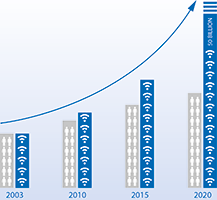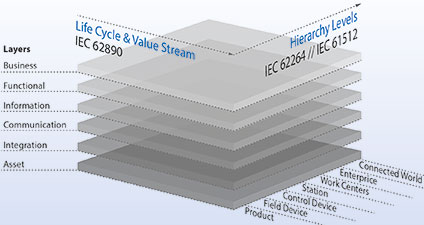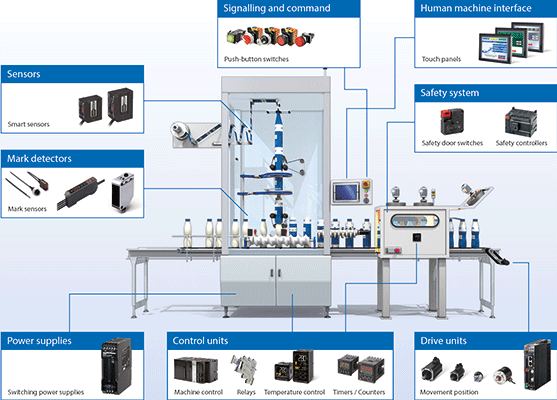

The advent of a fourth industrial revolution was first announced at the Hannover Messe in 2011. During that exhibition, the term ‘Industrie 4.0’ was coined by German Chancellor Angela Merkel to describe this revolution-to-come.
The first industrial revolution brought mechanisation to manufacturing, the second one electricity. In the ‘70s, a third revolution further enhanced production processes with the introduction of information technology. The first three revolutions were all identified in the aftermath. Now, for the first time, Industrie 4.0 describes a revolution before it happens, creating stimulus for its advent, rather than describing it afterwards.
Industrie 4.0 will help factories to answer individual customer requirements, it will address the growing need for increased productivity and efficiency, but it will also address social needs: supporting interactive collaboration between humans and machines. The fourth industrial revolution fits seamlessly into the model behind the SINIC theory, which Omron founder, Kazuma Tateishi, presented at the International Future Research Conference in 1970.
In the SINIC theory (Seed-Innovation to Need-Impetus Cyclic Evolution), science, technology and society share a cyclical relationship, mutually impacting and influencing each other. In the future Optimisation Society described by the SINIC theory, Tateisi predicts that technologies that automate parts of our human intellect and sensations will form the foundation for future development. In this future society, people and machines will find an ideal level of harmony.
This position paper outlines Omron’s contribution to a fully digitised manufacturing ecosystem and explains how its core technologies become the enabler to realise a smart digital automation infrastructure.
Overview on prominent digitalisation initiatives
Digitisation will impact the entire business environment. We see many changes already on the consumer side, where smartphones and apps have disrupted long-established business ecosystems with unexpected value propositions and cost saving potential. However, even in fully controlled industry ecosystems, Industrie 4.0 is not a standalone phenomenon. The process of digitisation has already enabled several successful usage-driven models outside Europe, such as the jet engine business of GE.

The fourth industrial revolution and the Internet of Things and Services
The first industrial revolution was marked by the introduction of mechanically supported processes in industry. In the second industrial revolution, electrical power enhanced the productivity of our factories. In the ‘70s the development of IT and factory automation gave boost to a third revolution. The fourth industrial revolution is characterised by a convergence of the physical world and the virtual one (cyberspace) in the form of CPS (cyber physical systems).
Moreover, this latest revolution has the potential for a more disruptive change than any previous industrial revolution. The pressure that it brings to data processing requirements is making the traditional Moore’s law inadequate to keep pace with current and future requirements, forcing the definition of new roadmaps for the evolution of processing power.
The extent of this need is easily imagined just by looking at the exponential growth of connected things.
This development forces all members of a supply chain, serving a particular segment, to consider how far they need to cooperate with partners, as well as to consider how scalable business platforms can be created and leveraged.
Whenever talking of connected objects, it is important to understand that the Internet of Things also includes physical devices that are not directly connected to the web or do not even carry any electronic intelligence. An object that simply makes its virtual representation available to an IT system, can be considered an Industrie 4.0 component.
As an example we can consider a simple relay produced in a fully traced production process. If you associate this relay with a unique serial number and store it in a QR code, you can use this code to identify the relay. Scanning this code will show you when it was produced, where, how, and on what route it was shipped to the customer. This relay can be used in a fully digitalised production line, where its code is scanned when it is installed in the cabinet. Age, specification, life expectancy and supply route for replacement then become immediately available in the system.
In addition, the control system can record the operations and the load applied to the contacts to predict the remaining life of the relay at all times. When this prediction indicates an increased probability of failure, the system can automatically order a replacement. This replacement can be installed in the next maintenance cycle of the machine, avoiding unexpected downtime and production loss.
We can consider the above relay combined with its digital virtual representation as an example of a simple Cyber Physical System (CPS), or simplest type of an Industrie 4.0 component.
Within Industrie 4.0 terminology, this virtual representation is better known as the administration shell of the corresponding physical device. In a more complex reality, simple components like the one described above can be nested within more complex high level components, for example a machine or an entire production line.
If we now look at machines, lines or plants, we recognise that we have a hierarchy of nested devices that build the system. The Industrie 4.0 component concept, together with its administration shell, has been defined to allow an easy and logical scalability of CPS.
The example of a simple CPS can also be useful to explain and clarify the real value behind the Internet of Things.
The power of digitisation is not in the data itself, in the connectivity or even in the processing capabilities of a device. The real value of the Internet of Things comes by using these cyber elements in order to make an object, a machine or a plant perform better. Within a CPS, the combination of cyber and physical elements can transform a product into a smart product, which can perform a much more useful function using the empowerment provided by the Internet of Things.
In a similar way, within the Internet of Services, large amounts of data can be processed autonomously in order to provide better and more useful services. Examples of these smart services include predictive and preventive maintenance, made possible by processing large amounts of data collected from running products or machines.

The way forward to digitisation
In 2014 PricewaterhouseCoopers released, in cooperation with VDMA and several industrial partners, a survey about the challenges and opportunities of industrial Internet. This study clearly shows the extent of the commitment required by industrial organisations to implement the digital transformation. It also stresses how future customer satisfaction and related corporate success are closely related to this transformation process.
This requires an incremental and structured approach to digitalisation. Manufacturing strategy and company infrastructure must be transformed carefully and requires a well thought out plan – a digitalisation strategy. To conduct the transformation, several changes in the business environment must happen, especially to ensure efficient integration of relevant business partners in the horizontal integrated ecosystem. A network of reliable partners is a crucial element to succeed in this challenge.
In a factory, vertical integration of communication is the key enabler to manage all the available assets and the relevant data. Vertical integration is enabled by a seamless communication infrastructure from plant level down to device level.
A proper digitalisation strategy must define all the key improvement areas and must set priority over the main value-added processes such as:
• Mass customisation, fast production changeover.
• Full lifecycle traceability and single product serialisation.
• Increased level of safety and security.
• The management of a scarce skilled workforce.
• Extensive machine collaboration.
• Fast design and installation, reduction of production downtime.
• Usage optimisation by condition monitoring and predictive maintenance.
The platform Industrie 4.0 has recently reconfirmed the research roadmap to be followed in order to achieve a full Industrie 4.0 implementation.
This roadmap shows that a fully digitised enterprise will not become reality before the 2030s, even if many technologies are already available to create and utilise digitised production. A successful company cannot just wait until all the technology is available, but it would also be wrong to surrender to the hype and get disappointed by expectations that cannot be met.
The best approach involves starting to use the available technology to address the most value-added digital applications and then gradually move on through the digital journey.
Machine automation at the heart of digitalisation
The Reference Architecture Model Industrie 4.0 (RAMI4.0) was created in 2015 in order to cover all aspects of development and to define a model that embraces the entire enterprise, down to the level of a single device.
This model classifies all aspects of a digitised production ecosystem. It consists of three axes addressing the most relevant dimensions:
• Layers axis: Six layers define the structural composition of properties within a line or machine.
• Hierarchy levels axis: This axis, associated with the IEC 62264 and IEC 61512 hierarchy levels, represents functionalities within the plant or enterprises. To achieve a holistic view, ‘Product’ and ‘Connected World’ have been added.
• Life cycle and value stream axis: This axis represents the entire lifecycle of either products or plants, and uses IEC 62890 as a base. It has been amended by the definition of ‘types’ and ‘instances’ to enable a fully scalable use of the Industrie 4.0 component concept.
The RAMI 4.0 full architecture is very powerful and extensive; however most companies cannot be expected to operate in the whole architecture. Partnerships need to be created across different players in order to achieve a full coverage of the complete architecture. Omron’s focus and specialisation is on machine automation.
Omron’s offer for digitised production
Successful implementation of digitalised production requires multiple core competences combined in the manufacturer’s ecosystem.
Machines are considered to be the core of production and therefore, systems that enable machines to perform are the core enablers for the usage of smart data in production.
Omron can provide a full range of machine automation products using future-proof hardware and software platforms. Its technology enables it efficiently and reliably to utilise communication and associated data to create smart systems. Advanced platform-based devices enable it to connect products (things) to relevant data and create machine focused Internet of Things solutions.

Conclusions
The fourth industrial revolution is just starting. The scalability of digital technology combined with the collective intelligence using emerging metadata sources promises a huge disruptive potential. However, we have massive hype at present and the expectation to get dramatic results in a short time may not be fulfilled.
The capability to see the real potential of digitisation and the ability to separate the hype from the real enablers will make the difference between success and failure in any digital venture. Omron’s experience in digital enabling technologies makes it capable of realising digitised production in its own factories around the world.
For more information contact Laetitia de Jager, Omron Electronics, +27 (0)11 579 2625, [email protected], www.industrial.omron.co.za
| Tel: | +27 11 579 2600 |
| Email: | [email protected] |
| www: | www.industrial.omron.co.za |
| Articles: | More information and articles about Omron Electronics |
© Technews Publishing (Pty) Ltd | All Rights Reserved